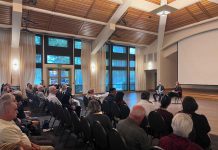I’ve pretty much discounted the reality (or rather, unreality) of the next few weeks of Christmas and am already looking forward to a new year. So is the governor it seems, as he seeks to devise a proposal that addresses the crisis of inadequate health care for the entire population of California. Because so many of California’s non-profits are health care providers or greatly impacted by the ramifications of poor health care policies and practices, the California Association of Non-profits asked about what is going on around the state, particularly in the area of private and public partnerships.
As I’ve written about before, South County has an extraordinary model of collaboration and partnership. In South Santa Clara County, our local non-profit health and human services providers have long worked closely with our public, government-sponsored health care programs. Since 1991, the South County Collaborative has focused on increasing access to health care services for all residents of the South County communities of Morgan Hill, San Martin and Gilroy, especially low-income, un-insured or under-insured residents. This effort began with a collaboration between Gilroy Unified School District and local non-profits to bring health clinics onto school sites and expand health services access to school families.
In the last few years, the Nutrition and Health subcommittee, co-chaired by Lillian Castillo, the South County program director for the county’s Public Health Nutrition Department, and Sr. Rachela Silvestri, the outreach coordinator for Saint Louise Regional Hospital, has placed emphasis on attacking the problem of obesity and the rise in Type II Diabetes, particularly among children, and taken the lead on several initiatives that could be replicable models elsewhere in the state:
n Development of the federally mandated Wellness Plan for Gilroy Unified School District. Although Santa Clara Unified’s plan received the most press up north, this group quietly worked to create one of the most comprehensive wellness plans developed in our county, going beyond the very basic requirements of the federal government (which is what some overwhelmed school districts are settling for) to address a wide array of health and wellness issues that could actually create a positive change in our community. With the constant support provided by the Nutrition and Health Committee, school representatives had broad-based representation from the community to develop the plan, which they completed. This plan was reviewed by the school staff, approved by the school board, and, most importantly, embraced by the community (unlike Santa Clara’s), long before the deadline.
n The production of Community Health Day. Community Health Day is an annual, one-day community health-fair that serves 800-1000 South County residents. It provides health, wellness and disease prevention within our South County community by increasing awareness of and direct access to health care resources specifically targeting underinsured, uninsured and underserved residents. Services include on-site blood sugar testing, blood pressure screening, cholesterol testing, nutrition counseling, mental health and substance abuse treatment/counseling, and children’s health and wellness education. The highlight of the health fair is the “Talk with a Doc,” in which attendees have a free consultation with a doctor about any concern they have. These have proved instrumental in catching conditions that, left untreated, turn into acute problems requiring expensive emergency care and sometimes, family-finance-destroying hospital stays. The project provides tens of thousands of dollars of health care resources.
The Nutrition and Health subcommittee is about to embark on another initiative – The HEAL – Healthy Eating, Active Living – Project. This project targets three low-income, high minority/immigrant neighborhoods in Gilroy and Morgan Hill to engage the community members in a variety of activities to decrease obesity and obesity-related health problems among the residents.
The geographic separation of south Santa Clara County from the county seat 35 miles north leaves us with scarce on-site resources and funding for local non-profit organizations. When one is looking for successful private-public partnerships, the work of the Collaborative’s nutrition and health committee provides a laudable model, especially given what we’re able to achieve with scarce resources.
They still face challenges, such as the best way to address hard to reach populations, and overcoming transportation barriers for their clients. However, the sincere commitment to the community, and the true respect and cooperation the representatives have demonstrated year after year, leave no doubt that they will come up with some kind of creative and effective way to address the problem, recognized by the governor or not.
Columnist Dina Campeau is a wife, mother of two teens and a resident of Morgan Hill. Her work for the last seven years has focused on affordable housing and homeless issues in Santa Clara County. Her column will be published each Friday. Reach her at dc******@*****er.net.







